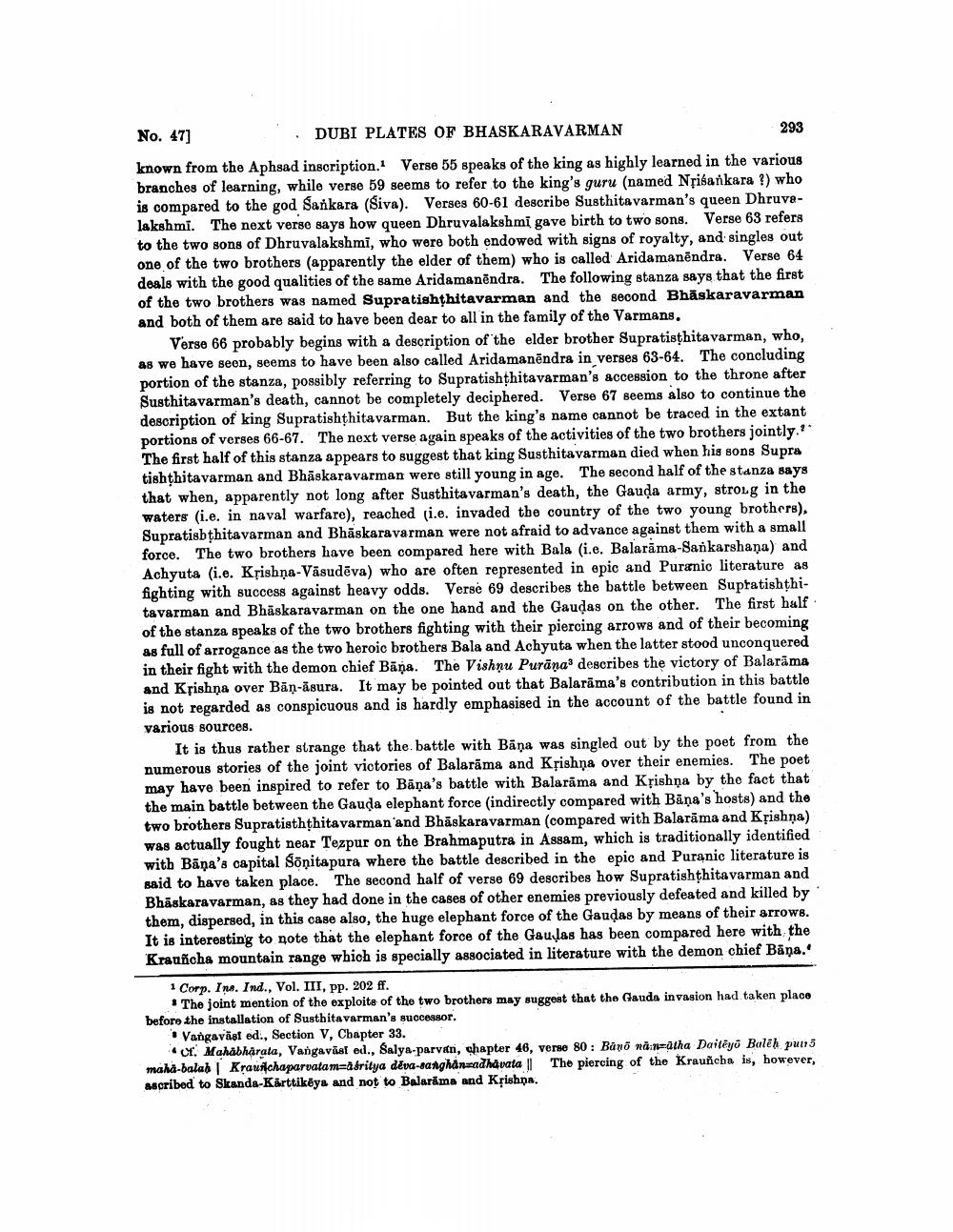________________
293
No. 47]
DUBI PLATES OF BHASKARAVARMAN
known from the Aphsad inscription.1 Verse 55 speaks of the king as highly learned in the various branches of learning, while verse 59 seems to refer to the king's guru (named Nrisankara ?) who is compared to the god Sankara (Siva). Verses 60-61 describe Susthitavarman's queen Dhruvelakshmi. The next verse says how queen Dhruvalakshmi gave birth to two sons. Verse 63 refers to the two sons of Dhruvalakshmi, who were both endowed with signs of royalty, and singles out one of the two brothers (apparently the elder of them) who is called Aridamanendra. Verse 64 deals with the good qualities of the same Aridamanendra. The following stanza says that the first of the two brothers was named Supratishthitavarman and the second Bhaskaravarman and both of them are said to have been dear to all in the family of the Varmans.
Verse 66 probably begins with a description of the elder brother Supratisthitavarman, who, as we have seen, seems to have been also called Aridamanendra in verses 63-64. The concluding portion of the stanza, possibly referring to Supratishthitavarman's accession to the throne after Susthitavarman's death, cannot be completely deciphered. Verse 67 seems also to continue the description of king Supratishthitavarman. But the king's name cannot be traced in the extant portions of verses 66-67. The next verse again speaks of the activities of the two brothers jointly." The first half of this stanza appears to suggest that king Susthitavarman died when his sons Supra tishthitavarman and Bhaskaravarman were still young in age. The second half of the stanza says that when, apparently not long after Susthitavarman's death, the Gauda army, strong in the waters (i.e. in naval warfare), reached (i.e. invaded the country of the two young brothers), Supratishthitavarman and Bhaskaravarman were not afraid to advance against them with a small force. The two brothers have been compared here with Bala (i.e. Balarama-Sankarshana) and Achyuta (i.e. Krishna-Vasudeva) who are often represented in epic and Puranic literature as fighting with success against heavy odds. Verse 69 describes the battle between Supratishthitavarman and Bhaskaravarman on the one hand and the Gaudas on the other. The first half. of the stanza speaks of the two brothers fighting with their piercing arrows and of their becoming as full of arrogance as the two heroic brothers Bala and Achyuta when the latter stood unconquered in their fight with the demon chief Bana. The Vishnu Purana3 describes the victory of Balarama and Krishna over Ban-asura. It may be pointed out that Balarama's contribution in this battle is not regarded as conspicuous and is hardly emphasised in the account of the battle found in
various sources.
It is thus rather strange that the battle with Baņa was singled out by the poet from the numerous stories of the joint victories of Balarama and Krishna over their enemies. The poet may have been inspired to refer to Bana's battle with Balarama and Krishna by the fact that the main battle between the Gauda elephant force (indirectly compared with Bana's hosts) and the two brothers Supratisththita varman and Bhaskaravarman (compared with Balarama and Krishna) was actually fought near Tezpur on the Brahmaputra in Assam, which is traditionally identified with Bana's capital Sõnitapura where the battle described in the epic and Puranic literature is said to have taken place. The second half of verse 69 describes how Supratishthitavarman and Bhaskaravarman, as they had done in the cases of other enemies previously defeated and killed by them, dispersed, in this case also, the huge elephant force of the Gaudas by means of their arrows. It is interesting to note that the elephant force of the Gaulas has been compared here with the Krauñcha mountain range which is specially associated in literature with the demon chief Bana.
1 Corp. Ins. Ind., Vol. III, pp. 202 ff.
The joint mention of the exploits of the two brothers may suggest that the Gauda invasion had taken place before the installation of Susthitavarman's successor.
Vangavast ed., Section V, Chapter 33.
4. Mahabharata, Vangaväst ed., Salya-parvan, chapter 46, verse 80: Bano nanatha Daileyo Baleh pun5 maha-balah Krauchaparvatam àbritya deva-sanghanzadhavata || The piercing of the Krauñcha is, however, ascribed to Skanda-Kärttikeya and not to Balarama and Krishna.




